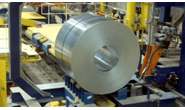Trade Cases

NAFTA Steel Requirements Unclear
Written by Sandy Williams
July 18, 2017
President Trump kicked off “Made in America Week” on Monday with a display of items from 50 states that were made in the U.S.A. The photo-op event immediately garnered criticism of the Trump family businesses that rely heavily on China and other Asian countries to manufacture their goods.
The NAFTA renegotiation objectives were released concurrently on Monday by the U.S. Trade Representative. The objectives include increasing opportunities for U.S. firms to sell U.S. products and services into NAFTA countries. A renegotiation would also keep in place domestic preferential government purchasing programs such as “Buy America” that would prevent Canada and Mexico from bidding on U.S. government contracts. The U.S seeks to “update and strengthen the rules of origin, as necessary, to ensure that the benefits of NAFTA go to products genuinely made in the United States and North America.”
An executive order April 18 set the United States on a protectionist path that stipulates Buy American and Hire American. Whether something can meet the Made in USA label requirement depends on the product. According to the Federal Trade Commission, “for a product to be called Made in USA, or claimed to be of domestic origin without qualifications or limits on the claim, the product must be ‘all or virtually all’ made in the U.S.”
The Commission stipulates that a product’s final assembly or processing must take place in the U.S. It then compares how much of the manufacturing costs can be attributed to U.S. parts and processing. Automobile qualification as Made in USA depends on site of assembly and the percentage of imported parts and processes. For steel intensive products like tools or pipes, the Commission also considers how much of the actual steel was sourced domestically vs. imported.
When defining steel as made in America, all manufacturing processes, from the initial melting stage through the application of coatings, must occur in the United States.
The language in the NAFTA objectives is vague on what will constitute U.S. products and did not specifically mention steel products. It is unclear whether U.S. steel-using industries will need to adhere to the melt-through-finishing requirement for sales within NAFTA. A NAFTA “Made in North America” designation does not appear to be in the works under the present administration.

Sandy Williams
Read more from Sandy WilliamsLatest in Trade Cases

Breaking News: Commerce releases prelim anti-dumping duties in sweeping trade case targeting CORE imports
The US Commerce Department on Friday released preliminary anti-dumping margins in a trade case targeted imports of coated flat-rolled steel from 10 countries. Certain countries and mills were hammered while others were largely spared. Brazilian steelmaker CSN, for example, received a preliminary rate of 137.76%. Some Turkish mills – including Boreclik and ArcelorMittal Celik Ticaret – received no dumping margin at all.

CRU: Trump’s sweeping tariffs could derail the US met coal industry
Latest tariffs could lead to US metallurgical coal exporters (many already high-cost swing producers) being priced out of the market.

Tariff fallout: Canada strikes back, Stellantis idles, GM boosts production
Canada imposes auto tariffs, while automaker Stellantis temporarily idles some plants.

Commerce tags UAE with ‘critical circumstances’ in CORE trade case, South Africa spared
The Commerce Department has made a preliminary determination that ‘critical circumstances’ exist for certain imports of corrosion-resistant (CORE) flat-rolled steel from the United Arab Emirates (UAE). Commerce decided that critical circumstances did not apply to CORE from South Africa. The department also found that critical circumstances did not apply to CORE from UAE producers Al-Ghurair Iron & Steel LLC and United Iron & Steel Company LLC.

Trump’s ‘Liberation Day’ brings 10% baseline tariffs; steel, aluminum, and autos/parts excluded
President Trump’s promised “Liberation Day” has arrived, with a 10% minimum tariff on imports. But there are some very important exceptions: The United States’ USMCA partners, Canada and Mexico, are excluded from the reciprocal tariffs for now. In addition, steel, aluminum, as well as autos and auto parts are excluded from the reciprocal tariffs. That’s […]
